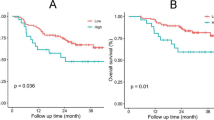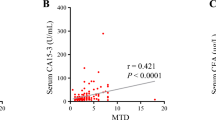Abstract
Objective
This study was designed to detect the changes of serum soluble Fas (sFas) levels in patients with locally advanced unresectable rectal cancer (LAURC), and to explore its prognostic value of response.
Methods
Soluble samples were obtained from LAURC subjects, treated by concurrent chemoradiotherapy, before treatment and one month after treatment. Healthy donor serum samples were used as controls. sFas concentration was measured by enzyme-linked immunosorbent assay (ELISA).
Results
The sFas levels before treatment and one month after treatment were both significantly higher in LAURC subjects than in healthy controls [(8.79±1.39) and (7.74±1.32) vs. (5.53±1.13) ng/L, P<0.01]. The sFas levels before treatment and one month after treatment were significantly lower in the response group (complete and partial responses) than in the non-response group (stable and progressive diseases) [(8.50±1.25) vs. (10.17±1.26) ng/L, P<0.01 and (7.50±1.24) vs. (8.90±1.13) ng/L, P<0.01, respectively]. The one-year survival rate was 54.2% and 82.6% in those with sFas levels >8.79 ng/L and <8.79 ng/L before treatment (P<0.02), respectively, 50.0% and 87.0% in those with sFas levels >7.74 ng/L and <7.74 ng/L one month after treatment (P<0.01), respectively.
Conclusions
The sFas level is higher in LAURC subjects than in healthy controls. Concurrent chemoradiotherapy can reduce sFas levels in LAURC patients. The monitoring of sFas may provide prognostic information for LAURC patients.
Similar content being viewed by others
References
Abbasova, S.G., Vysotskii, M.M., Ovchinnikova, L.K., Obusheva, M.N., Digaeva, M.A., Britvin, T.A., Bahoeva, K.A., Karabekova, Z.K., Kazantzeva, I.A., Mamedov, U.R., et al., 2009. Cancer and soluble Fas. Bull. Exp. Biol. Med., 148(4):638–642. [doi:10.1007/s10517-010-0784-8]
Bewick, M., Conlon, M., Parissenti, A.M., Lee, H., Zhang, L., Glück, S., Lafrenie, R.M., 2001. Soluble Fas (CD95) is a prognostic factor in patients with metastatic breast cancer undergoing high-dose chemotherapy and autologous stem cell transplantation. J. Hematother. Stem. Cell. Res., 10(6):759–768. [doi:10.1089/152581601317210854]
Boroumand-Noughabi, S., Sima, H.R., Ghaffarzadehgan, K., Jafarzadeh, M., Raziee, H.R., Hosseinnezhad, H., Moaven, O., Rajabi-Mashhadi, M.T., Azarian, A.A., Mashhadinejad, M., et al., 2010. Soluble Fas might serve as a diagnostic tool for gastric adenocarcinoma. BMC Cancer, 10(1):275. [doi:10.1186/1471-2407-10-275]
Bosset, J.F., Calais, G., Daban, A., Berger, C., Radosevic-Jelic, L., Maingon, P., Bardet, E., Pierart, M., Briffaux, A., EORTC Radiotherapy Group, 2004. Preoperative chemoradiotherapy versus preoperative radiotherapy in rectal cancer patients: assessment of acute toxicity and treatment compliance. Report of the 22921 randomised trial conducted by the EORTC Radiotherapy Group. Eur. J. Cancer, 40(2):219–224. [doi:10.1016/j.ejca.2003.09.032]
Cascino, I., Fiucci, G., Papoff, G., Ruberti, G., 1995. Three functional soluble forms of the human apoptosis-inducing Fas molecule are produced by alternative splicing. J. Immunol., 154(6):2706–2713.
Chaudhry, P., Srinivasan, R., Patel, F.D., Gopalan, S., Majumdar, S., 2008. Serum soluble Fas levels and prediction of response to platinum-based chemotherapy in epithelial ovarian cancer. Int. J. Cancer, 122(8):1716–1721. [doi:10.1002/ijc.23213]
Debatin, K.M., Krammer, P.H., 2004. Death receptors in chemotherapy and cancer. Oncogene, 23(16):2950–2966. [doi:10.1038/sj.onc.1207558]
Eichhorst, S.T., Müerköster, S., Weigand, M.A., Krammer, P.H., 2001. The chemotherapeutic drug 5-fluorouracil induces apoptosis in mouse thymocytes in vivo via activation of the CD95 (APO-1/Fas) system. Cancer Res., 61(1):243–248.
Gratas, C., Tohma, Y., Barnas, C., Taniere, P., Hainaut, P., Ohgaki, H., 1998. Up-regulation of Fas (APO-1/CD95) ligand and down-regulation of Fas expression in human esophageal cancer. Cancer Res., 58(10):2057–2062.
Griffith, T.S., Brunner, T., Fletcher, S.M., Green, D.R., Ferguson, T.A., 1995. Fas ligand-induced apoptosis as a mechanism of immune privilege. Science, 270(5239):1189–1192. [doi:10.1126/science.270.5239.1189]
Havenga, K., Enker, W.E., Norstein, J., Moriya, Y., Heald, R.J., van Houwelingen, H.C., van de Velde, C.J., 1999. Improved survival and local control after total mesorectal excision or D3 lymphadenectomy in the treatment of primary rectal cancer: an international analysis of 1411 patients. Eur. J. Surg. Oncol., 25(4):368–374. [doi:10.1053/ejso.1999.0659]
Jodo, S., Kobayashi, S., Nakajima, Y., Matsunaga, T., Nakayama, N., Ogura, N., Kayagaki, N., Okumura, K., Koike, T., 1998. Elevated serum levels of soluble Fas/APO-1 (CD95) in patients with hepatocellular carcinoma. Clin. Exp. Immunol., 112(2):166–171. [doi:10.1046/j.1365-2249.1998.00569.x]
Kachnic, L.A., 2007. Adjuvant chemoradiation for localized rectal cancer: current trends and future directions. Gastrointest. Cancer Res., 1(4 Suppl. 2):S64–S72.
Kimura, K., Gelmann, E.P., 2000. Tumor necrosis factor-alpha and Fas activate complementary Fas-associated death domain-dependent pathways that enhance apoptosis induced by gamma-irradiation. J. Biol. Chem., 275(12):8610–8617. [doi:10.1074/jbc.275.12.8610]
Klautke, G., Feyerherd, P., Ludwig, K., Prall, F., Foitzik, T., Fietkau, R., 2005. Intensified concurrent chemoradiotherapy with 5-fluorouracil and irinotecan as neoadjuvant treatment in patients with locally advanced rectal cancer. Br. J. Cancer, 92(7):1215–1220. [doi:10.1038/sj.bjc.6602492]
Kushlinskii, N.E., Britvin, T.A., Abbasova, S.G., Perevoshchikov, A.G., Prorokov, V.V., Kostanyan, I.A., Knysh, V.I., Lipkin, V.M., 2001. Soluble Fas antigen in the serum of patients with colon cancer. Bull. Exp. Biol. Med., 131(4):361–363. [doi:10.1023/A:1017908320634]
Liang, Q.L., Pan, D.C., Yin, Z.M., Liu, G.X., Yang, Q., Xie, J.R., Cai, L.Z., Fu, Y.W., 2002. Clinical value of serum soluble Apo-1/Fas for predicting biological behaviors and prognosis of gastric carcinoma. Ai Zheng, 21(2):174–176 (in Chinese).
Liang, Q.L., Wang, B.R., Li, G.H., 2009. DcR3 and survivin are highly expressed in colorectal carcinoma and closely correlated to its clinicopathologic parameters. J. Zhejiang Univ.-Sci. B, 10(9):675–682. [doi:10.1631/jzus.B0920077]
Natoli, G., Ianni, A., Costanzo, A., de Petrillo, G., Ilari, I., Chirillo, P., Balsano, C., Levrero, M., 1995. Resistance to Fas-mediated apoptosis in human hepatoma cells. Oncogene, 11(6):1157–1164.
Naumnik, W., Izycki, T., Ossolinska, M., Chyczewska, E., 2007. Serum levels of sFas and sFasL during chemotherapy of lung cancer. Exp. Oncol., 29(2):132–136.
Nesbakken, A., Nygaard, K., Westerheim, O., Mala, T., Lunde, O.C., 2002. Local recurrence after mesorectal excision for rectal cancer. Eur. J. Surg. Oncol., 28(2):126–134. [doi:10.1053/ejso.2001.1231]
Pan, G., Ahn, E.Y., Chen, Y., Feng, G., Reddy, V., Jhala, N.C., McDonald, J.M., 2007. Reciprocal co-expression of Fas and Fas ligand in human cholangiocarcinoma. Int. J. Oncol., 31(4):843–850.
Petak, I., Tillman, D.M., Harwood, F.G., Mihalik, R., Houghton, J.A., 2000. Fas-dependent and independent mechanisms of cell death following DNA damage in human colon carcinoma cells. Cancer Res., 60(10):2643–2650.
Shimizu, M., Kondo, M., Ito, Y., Kume, H., Suzuki, R., Yamaki, K., 2005. Soluble Fas and Fas ligand provide new information on metastasis and response to chemotherapy in SCLC patients. Cancer Detect. Prev., 29(2):175–180. [doi:10.1016/j.cdp.2004.09.001]
Spindler, K.L., Nielsen, J.N., Lindebjerg, J., Brandslund, I., Jakobsen, A., 2006. Prediction of response to chemoradiation in rectal cancer by a gene polymorphism in the epidermal growth factor receptor promoter region. Int. J. Radiat. Oncol. Biol. Phys., 66(2):500–504. [doi:10.1016/j.ijrobp.2006.03.030]
Suda, T., Takahashi, T., Golstein, P., Nagata, S., 1993. Molecular cloning and expression of the Fas ligand a novel member of the tumor necrosis factor family. Cell, 75(6):1169–1178. [doi:10.1016/0092-8674(93)90326-L]
Zhu, Q., Han, S.X., Li, M.Z., Su, B.S., Ma, J.L., 2006. The expression of Fas, p53, Bcl-2 and cervix carcinoma cell apoptosis during radiotherapy. Modern Oncol., 14(6):730–732 (in Chinese).
Author information
Authors and Affiliations
Corresponding author
Rights and permissions
About this article
Cite this article
Liang, Ql., Li, Zy., Chen, Gq. et al. Prognostic value of serum soluble Fas in patients with locally advanced unresectable rectal cancer receiving concurrent chemoradiotherapy. J. Zhejiang Univ. Sci. B 11, 912–917 (2010). https://doi.org/10.1631/jzus.B1000277
Received:
Accepted:
Published:
Issue Date:
DOI: https://doi.org/10.1631/jzus.B1000277




